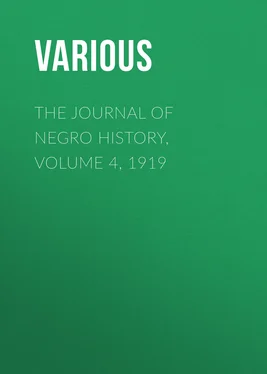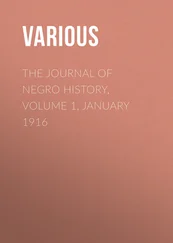Various - The Journal of Negro History, Volume 4, 1919
Здесь есть возможность читать онлайн «Various - The Journal of Negro History, Volume 4, 1919» — ознакомительный отрывок электронной книги совершенно бесплатно, а после прочтения отрывка купить полную версию. В некоторых случаях можно слушать аудио, скачать через торрент в формате fb2 и присутствует краткое содержание. Жанр: foreign_antique, periodic, История, foreign_edu, на английском языке. Описание произведения, (предисловие) а так же отзывы посетителей доступны на портале библиотеки ЛибКат.
- Название:The Journal of Negro History, Volume 4, 1919
- Автор:
- Жанр:
- Год:неизвестен
- ISBN:нет данных
- Рейтинг книги:5 / 5. Голосов: 1
-
Избранное:Добавить в избранное
- Отзывы:
-
Ваша оценка:
- 100
- 1
- 2
- 3
- 4
- 5
The Journal of Negro History, Volume 4, 1919: краткое содержание, описание и аннотация
Предлагаем к чтению аннотацию, описание, краткое содержание или предисловие (зависит от того, что написал сам автор книги «The Journal of Negro History, Volume 4, 1919»). Если вы не нашли необходимую информацию о книге — напишите в комментариях, мы постараемся отыскать её.
The Journal of Negro History, Volume 4, 1919 — читать онлайн ознакомительный отрывок
Ниже представлен текст книги, разбитый по страницам. Система сохранения места последней прочитанной страницы, позволяет с удобством читать онлайн бесплатно книгу «The Journal of Negro History, Volume 4, 1919», без необходимости каждый раз заново искать на чём Вы остановились. Поставьте закладку, и сможете в любой момент перейти на страницу, на которой закончили чтение.
Интервал:
Закладка:
To extend the work of the Association the Director of Research is now making an effort to secure the cooperation of five persons who, like Mr. Julius Rosenwald, will contribute $400 annually to the support of this cause. Mr. Moorfield Storey and Mr. Cleveland H. Dodge have each pledged themselves to give this amount. It is earnestly hoped that other philanthropists will subscribe.
The Journal of Negro History
Vol. IV—April, 1919—No. 2
THE CONFLICT AND FUSION OF CULTURES WITH SPECIAL REFERENCE TO THE NEGRO 79 79 This address was delivered before the American Sociological Society convened in annual session at Richmond in 1918.
Under ordinary circumstances the transmission of the social tradition is from the parents to the children. Children are born into society and take over its customs, habits, and standards of life simply, naturally, and without conflict. But it will at once occur to any one that the life of society is not always continued and maintained in this natural way, by the succession of parents and children. New societies are formed by conquest and by the imposition of one people upon another. In such cases there arises a conflict of cultures and as a result the process of fusion takes place slowly and is frequently not complete. New societies are frequently formed by colonization, in which case new cultures are grafted on to older ones. The work of missionary societies is essentially one of colonization in this sense.
Finally we have societies growing up, as in the United States, by immigration. These immigrants, coming as they do from all parts of the world, bring with them fragments of divergent cultures. Here again the process of assimilation is slow, often painful, not always complete. In the case where societies are formed and maintained by adoption, that is by immigration, the question arises: How far is it possible for a people of a different race and a different culture to take over the traditions and social inheritance of another and an alien people? What are the conditions which facilitate this transmission and, in general, what happens when people of different races and cultures are brought together in the intimate relations of community life?
These questions have already arisen in connection with the education of the Negro in America and with the work of foreign missions. If the schools are to extend and rationalize the work they are already doing in the Americanization of the immigrant peoples, questions of this sort may become actual in the field of pedagogy. This paper is mainly concerned with the Negro, not because the case of the Negro is more urgent than or essentially different from that of the immigrant, but because the materials for investigation are more accessible.
Admitting, as the anthropologists now seem disposed to do, that the average native intelligence in the races is about the same, we may still expect to find in different races certain special traits and tendencies which rest on biological rather than cultural differences. For example, over and above all differences of language, custom or historic tradition, it is to be presumed that Teuton and Latin, the Negro and the Jew—to compare the most primitive with the most sophisticated of peoples—have certain racial aptitudes, certain innate and characteristic differences of temperament which manifest themselves especially in the objects of attention, in tastes and in talents. Is the Jewish intellectual, for example, a manifestation of an original and peculiar endowment of the Jewish race or is he rather a product of traditional interest and emphasis characteristic of Jewish people—a characteristic which may be explained as an accommodation to the long-continued urban environment of the race? 80 80 "The City: Suggestions for the Investigation of Human Behavior in the City Environment," American Journal of Sociology , V, 44, March, 1915, p. 589.
Is the Negro's undoubted interest in music and taste for bright colors, commonly attributed to the race, to be regarded as an inherent and racial trait or is it merely the characteristic of primitive people? Is Catholicism to be regarded as the natural manifestation of the Latin temperament as it has been said that Protestantism is of the Teutonic?
Here are differences in the character of the cultural life which can scarcely be measured quantitatively in terms of gross intellectual capacity. Historical causes do not, it seems, adequately account for them. So far as this is true we are perhaps warranted in regarding them as modifications of transmitted tradition due to innate traits of the people who have produced them. Granted that civilization, as we find it, is due to the development of communication and the possibility of mutual exchange of cultural materials, still every special culture is the result of a selection and every people borrows from the whole fund of cultural materials not merely that which it can use but which, because of certain organic characteristics, it finds stimulating and interesting.
The question then resolves itself into this: How far do racial characteristics and innate biological interests determine the extent to which one racial group can and will take over and assimilate the characteristic features of an alien civilization? How far will it merely take over the cultural forms, giving them a different content or a different inflection? This problem, so far as it is related to the lives of primitive peoples, has already been studied by the ethnologists. Rivers, in his analysis of the cultures of Australian people, has found that what we have hitherto regarded as primitive cultures are really fusions of other and earlier forms of culture. 81 81 Rivers, "Ethnological Analysis of Cultures," Nature , Vol. I, 87, 1911.
The evidence of this is the fact that the fusion has not been complete. In the process of interchange it frequently happens that what Rivers calls the "fundamental structure" of a primitive society has remained unchanged while the relatively formal and external elements of alien culture only have been taken over and incorporated with it.
There are indications also that, where cultural borrowings have taken place, the borrowed elements have for the people who have taken them over a meaning different from what they had for the people from whom they were borrowed. W.J. McGee, in an article entitled "Piratical Acculturation," has given an interesting illustration of this fact. 82 82 W. J. McGee, Piratical Acculturation .
McGee's observations of the Beri Indians go to show that they imitated the weapons of their enemies, but that they regarded them as magical instruments and the common people did not even know their names. There are numerous other illustrations of this so-called "piratical acculturation" among the observations of ethnologists. It is said that the Negroes in Africa, when they first came into possession of the white man's guns, regarded them as magical instruments for making a noise and used them, as the Germans used the Zeppelins and the newspapers, merely to destroy the enemy's morale.
No doubt the disposition of primitive peoples is to conceive everything mystically, or animistically, to use the language of ethnology, particularly where it concerns something strange. On the other hand, when the primitive man has encountered among the cultural objects to which civilization has introduced him, something which he has been able to make immediately intelligible to himself, he has at once formed a perfectly rational conception of it. Some years ago at Lovedale, South Africa, the seat of one of the first successful industrial mission schools, there was an important ceremony to which all the native African chiefs in the vicinity were formally invited. It was the introduction and demonstration of the use of the plow, the first one that had ever been seen in those parts. The proceedings were followed with great interest by a large gathering of natives. When the demonstration was finished one old chief turned to his followers and said with great conviction: "This is a great thing which the white man has brought us. One hoe like that is worth as much as ten wives." An African chief could hardly have expressed appreciation of this one fundamental device of our civilization in more pragmatic or less mystical terms. The wise old chief grasped the meaning of the plow at once, but this was because he had been pre-adapted by earlier experience to do so.
Читать дальшеИнтервал:
Закладка:
Похожие книги на «The Journal of Negro History, Volume 4, 1919»
Представляем Вашему вниманию похожие книги на «The Journal of Negro History, Volume 4, 1919» списком для выбора. Мы отобрали схожую по названию и смыслу литературу в надежде предоставить читателям больше вариантов отыскать новые, интересные, ещё непрочитанные произведения.
Обсуждение, отзывы о книге «The Journal of Negro History, Volume 4, 1919» и просто собственные мнения читателей. Оставьте ваши комментарии, напишите, что Вы думаете о произведении, его смысле или главных героях. Укажите что конкретно понравилось, а что нет, и почему Вы так считаете.












